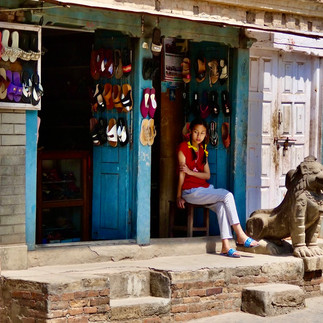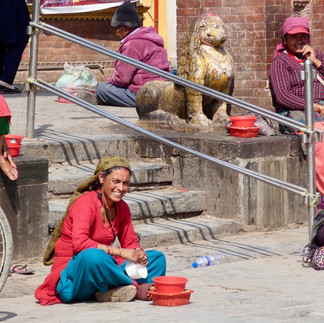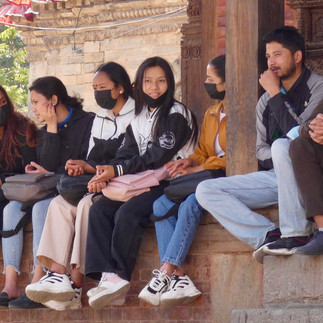Nepal's twin curses: the Shahs and the Ranas
- Jan Dehn

- Mar 28, 2023
- 7 min read
Updated: Apr 27

Like Bhutan and India, Nepal’s history of Democracy is surprisingly recent. Nepal only adopted its first genuinely democratic constitution in the year 2015. Since then, Nepal has had two general elections (2017 and 2022) and three presidential elections (2015, 2018, and 2023).
Prior to 2015, political power in Nepal was effectively monopolised by the Shah Royal family dynasty and the Rana dynasty of Prime Ministers. The actions of both dynasties reveal a shocking lack of concern for the national interest or the wellbeing of Nepalis. Instead, the two dynasties cared about acquiring power and wealth, no matter the cost to Nepal. Their ruthlessness meant that it took extraordinary events, including an earth quake, a civil war, and a royal massacre to finally end Nepal’s twin curses of the Shahs and the Ranas.
Our story starts prior to 1768, when there was not even such thing as a Nepali nation. Power was distributed over several families, some of which were more influential, such as the Thakuris, Mallas, and Simrouns, but none were strong enough to unify the country.
This changed when King Prithvi Narayan Shah of the so-called Gorkha Empire, in what today is central Nepal, defeated rival fiefdoms and established a unified Kingdom of Nepal for the very first time.
Shah was the first in a long line of Kings of Nepal. The Shah dynasty continued for the next 240 years until the formal abolition of monarchy in in 2008. During its long spell in power, the Shah dynasty made no attempt to share power, perhaps with the sole exception of King Tribhuvan (more on him below). Instead, power was jealously guarded and only reluctantly ceded to others under the greatest of pressures.
The first serious assault on Shah power took place after the so-called Kot Massacre on 14 September 1846, when Jung Bahadur Rana had 30-40 senior political figures close to then King Chautariya Fateh Jung Shah killed. The massacre immediately rendered the King a lame duck and the Shah Dynasty was not to return to real power for the next 104 years.
The Ranas ruled through a succession of autocratic and ruthless Prime Ministers (PMs). During this time, the Shah royals were confined to holding ceremonial positions with no real power. The hereditary prime ministership of the Ranas only ended in the Revolution in 1951. This popular revolt was motivated by a number of factors, including Indian Independence, growing influence from educated classes and students, and growing internal divisions within the Rana Dynasty.
The Revolution of 1951 was preceded by a number of pivotal events. Notably, in November, 1950, King Tribhuvan – who has given name to Kathmandu’s main airport – left Nepal for self-imposed exile in India in protest against Rana rule. In a bid to neutralise the negative political fallout from Tribhuvan’s departure, the Ranas installed Tribhuvan’s 3-year-old grandson Gyanendra Bir Bikram Shah as replacement king. A remarkable picture on display in The Durbar (old royal palace) shows the child Gyanendra walking hand in hand with the PM on 6 November 1950, when he was declared King.
Baby Gyanendra is declared King

Gyanendra’s ascent to the throne did not go down well in Nepal. Gyanendra was rightly seen as a Rana puppet. The Nepali Congress Party (NPC), a political party modelled on the India’s Congress Party and the dominant movement for democratic reform in Nepal at the time, called for armed rebellion.
On February 18, 1951, Mohan Shumsher Jung Bahadur Rana, the last Rana PM, was forced to sign the Tri-partite Agreement with NPC and Tribhuvan. The agreement facilitated Tribhuvan’s return to Nepal and the throne, ending 104 years of Rana rule.
However, this was not the end of autocracy in Nepal. While the Ranas never regained power, Trihvuvan was now in charge. While he supported a new constitution that included significant steps towards Democracy, progress was slow. The new constitution was eventually adopted in 1959, paving the way for Nepal’s first election, which the NPC won. Within months, however, in 1960, the then-King Mahendra dissolved parliament and assumed absolute power. This marked the start of another 30 years of absolute monarchy in Nepal, nullifying all the progress towards Democracy that had been achieved after the 1951 Revolution.
How was such a reversal even possible, one might ask? It is important to remember that this period coincided with the height of the Cold War during which autocrats across many Emerging Market countries were able to hold on to power in spite of widespread public discontent by relying on guns and money from one Superpower or another, in exchange for loyalty to the Superpower of choice.
In light hereof, it is unsurprising that the next challenge against the Shah Royal Family was only able to take place after the end of the Cold War. In 1990, a People’s Movement, inspired by democratic revolutions across the former Soviet Union and the end of US-sponsored dictatorships in Latin America and parts of Asia, forced then King Birendra to adopt democratic reforms, leading to the first Presidential Election in Nepal in May of 1991.
Even so, many Nepalis were unhappy with the still disproportionately large role of the monarchy in Nepal. On 13 February 1996, Maoist rebels took over several parts of Kathmandu. In the following years, the Maoist insurgency gained support. By 1999, the rebels were active in three quarters of Nepali provinces, while about one quarter of Nepal’s provinces were under direct control of the rebels. In January 2001, the army was deployed to fight the Maoists, but with little impact. Ultimately, some 70,000 would perish in the civil war.
Kathmandu 2023

However, in June of 2001 a shocking event took place in the Royal Palace in Kathmandu, which was ultimately to have a detrimental effect on the rule of the Shahs in Nepal. Crown Prince Dipendra, the oldest son of King Birendra, allegedly killed not only his father, but also thirteen other members of his own family. Dipendra himself was left comatose with a bullet in his brain. He was king for three days, while comatose, until he died of his wounds.
Dipendra at a dinner at the Krishnarpan Restaurant in the Dwarika's Hotel, Kathmandu

To this day, the massacre remains shrouded in mystery and conspiracy theories. However, the facts are as follows:
· Dipendra’s gunshot wound was on his left temple, but he is right-handed.
· Almost all of those killed were on Dipendra’s side of the family, including Dipendra’s younger brother, who was second in line to the throne after Dipendra himself.
· Former child-King Gyanendra emerged as the legitimate heir to the throne and none of his side of the family had been killed.
In light of these observations, many believe that Gyanendra ordered the killings. He may have felt that he was the rightful king, having held the title as a 3-year-old during Tribhuvan’s exile. He may have been worried about the return of Rana influence, since Dipendra intended to marry Devyani Rana, the great-grand daughter of the last Rana PM. Finally, he may have been angry at transition towards constitutional monarchy.
Whatever the truth, Gyanendra became King for the second time after Dipendra died and immediately re-introduced absolute rule, arguing for the need to strong stable government in the turmoil caused by the massacre and the ongoing civil war.
Within five years, however, a second People’s Movement had emerged in opposition to Gyanendra’s rule. The movement was sufficiently broad-based to force Gyanendra to relinquish power and re-instate parliament by April of 2006. By November 21, 2006, the Comprehensive Peace Agreement was signed with the Maoist rebels.
In April, 2008, a Constitutional Assembly election took place in order to write a new constitution. On 28 May, 2008, Nepal was declared a Republic, finally ending 240 years of misrule by the Shahs and the Ranas. A presidential election was held in July 2008.
As an aside, King Gyanendra stands out as a great symbol of the abusive tendencies of Nepal’s pre-Democracy autocrats. The last of the Shah kings and the only Nepali to have been king twice, Gyanendra’s lust for power was extreme. Although there is no proof, he may well have gone as far as ordering the massacre of parts of his own family to regain power. During his second stint as King, he wasted no time abolishing Democracy in order to assume absolute power. He only relinquished power because the world around him had changed so much that he could longer keep hold of the reigns of power. Even to this day Gyanendra is trying to regain power. In 2012, he pledged to return as King of Nepal. The threat is not entirely an idle one; Gyanendra was able to retain his fortune after being deposed, reputedly leaving the palace with more than 40 truck-loads of valuables. His net worth is estimated to be in the hundreds of millions of Dollars, enough to make anyone political.
This brings us to the final chapter in Nepal’s painful road to Democracy. The Constitutional Assembly, which was set up in 2008 failed in its task to write a new constitution. It was therefore dissolved in 2012 and a new Constitutional Assembly was elected in November 2013. The new assembly was also unable to make much progress, thereby leaving Nepal with a dangerous structural deficiency at the very heart of its democratic system.
It finally took an earth quake to break the impasse. Literally. In April 2015, Nepal was rocked by massive tremors. The damage from the quake was so extensive that the mood in the country changed; minor political differences were set aside in order to get the Constitution passed, so that the government could effectively oversee reconstruction efforts. On 20 September, 2015, Nepal’s constitution was finally approved with an overwhelming majority in a referendum.
Today, the Federal Republic of Nepal is a proper Democracy. This does not guarantee stability, of course. Far from it. But at least the country is governed by representatives of the people rather than by arbitrary elites, like the Shahs and the Ranas. With freedom to choose comes responsibility. Nepalis - a small selection of whom are shown in pictures below - can no longer blame bad government and institutional failure on anyone other than themselves. After all, Democracy means that you get exactly what you vote for.
The End






















Comments